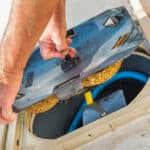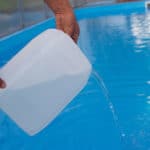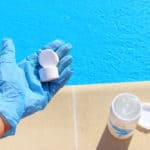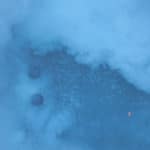There are many different ways that you can tell if your pool is leaking. The most common symptom is if you notice the water levels consistently decreasing. This can be caused by evaporation though, so read on to find out how to determine the difference.
If you notice wet spots appearing in your backyard, this commonly suggests a pool leak. These areas may be mushy and soft to the touch, and will exhibit a variance in grass growth.

You may also notice your garden landscaping moving and sinking due to underground erosion caused by the excess water.
If your pool wall tiles are cracking or falling off, this suggests a leak is present. The water in the ground surrounding your pool will unsettle the soil and cause movement. Over time, this can have an impact on the structure of your pool.
If your pool is fitted with an automatic fill device, you may not notice the water levels decreasing. If you see your water bills rising rapidly with no other explanation, this could indicate that your pool is leaking.
How do I know if my pool is leaking or evaporating?
As a general rule, your pool should not lose more than ¼ inch water daily in a humid environment, or ½ inch water in a drier environment. If you notice your pool water levels dropping more rapidly than this, it is probably a good idea to inspect for a leak.
Evaporation levels will vary according to a number of factors. These include the wind speed, the humidity, the surface area of the pool, and the variance between the water and air temperatures.
To check whether the decline in water levels is due to evaporation or a leak, there is a simple test you can perform. Turn off the pool’s auto-fill device and breaker. Fill it to the normal water level and mark the point on the wall that it reaches.
Grab a large bucket and fill it with water from the pool, leaving an inch of space empty at the top. Place this bucket on the top step of your pool and mark the water level here too.
Leave the bucket and pool to sit, inactive, for 24 hours. Once this time has passed, check the water levels, and note the results.
Refill the bucket and pool to the original lines that you made. Turn on the breaker and leave for a further 24 hours.
If the water levels dropped similar quantities in both the pool and bucket, the water has been lost to evaporation. If the pool levels dropped more than the bucket, you have a leak.
How much does it cost to fix an inground pool leak?
There are many different things that can go wrong with an inground pool. All of these can result in a leak and they all vary in their repair costs.
Issue | Fix | Average cost |
There is a broken seal around the skimmer | The gasket will need to be replaced | $100 - 125 |
There is a broken seal around the light | The gasket will need to be replaced | $125 - 175 |
You need to replace the vinyl liner beading | The beading will need to be replaced so the liner is tacked down sufficiently | $130 - 200 |
There are spreading cracks in the fiberglass | The cracked area will need cleaning, sanding, and covering in a new layer of gelcoat | $300 - 500 |
There is a small hole or tear in the vinyl liner | A vinyl liner patch and adhesive will need to be added to cover the hole | $350 - 550 |
There is a crack in the plaster | The crack will need to be filled with cement and the area will need replastering | $500 - 700 |
There is a large hole or tear in the vinyl liner | The liner will need to be replaced | $1,700 - 2,500 |
There is a crack in the pool beam | The crack will need patching and resurfacing along the entire length of the pool | $4,000 - 5,000 |
Where does the water go when a pool leaks?
When a pool leaks, the water tends to travel into the surrounding ground. Once it is here, it will try to find the lowest point. This means that generally it will travel through the soil column and into the water table.
Eventually, it will travel with the natural groundwater and will eventually find its way to a larger body of water such as the ocean or a river. If your soil is particularly tight, a large leak can create a mound in your yard where the water has collected.
Can a pool leak cause a sinkhole?
Yes, a pool leak can cause a sinkhole. Actually, leaking water (whether from homes or pools) is the leading cause of sinkholes. This means that it is absolutely vital you monitor your pool for leaks so that you can catch problems early, before they cause serious damage.
There are areas of the world where sinkholes are more likely to occur. These are areas with underground rocks that contain high quantities of salt, gypsum, or limestone.
This makes up approximately 40% of the bedrock in the United States. The states that are more prone to developing sinkholes include Tennessee, Florida, Pennsylvania, Texas, Kentucky, Alabama, and Missouri.
If you have found a sinkhole, the first thing that you should do is to keep your distance from it. The ground’s structural integrity is very weak, making it dangerous to walk across.
Ensure children, the elderly, and animals are kept well clear. We recommend erecting a fence around the impacted area to ensure no one crosses it.
If you suspect the sinkhole is due to a leak in your pool, you should contact a leak detection company immediately. You should also contact your insurance company to see what they will cover.
The leak detection company will find and repair the leak in your pool. This will prevent the sinkhole from growing and becoming more dangerous. You should fill the sinkhole with mud or sand to prevent accidents from happening.
Where do most pool leaks occur?
Pool leaks can occur anywhere on the inside or outside of your pool. The first places that you should check are the filter system, the pump, the heater, and the chlorinator.
If your pool is an inground one, the piping underneath the ground may be cracked. If you suspect that this is the problem, you should call a pool professional to pressure test the lines.
You should check around the pool’s edges to see where the leak is occurring. Once you have a rough idea, it is time to use dye, such as this one from Amazon.com, to pinpoint the leak.
Squirt leak finding dye (or food coloring) into the water, close to the wall of the pool. Pay attention to the direction the dye is traveling in - it will be moving towards the source of the leak.
If you suspect that the leak is on the pool’s floor, you should put on some protective goggles and repeat this test at the bottom of the pool. Try not to disturb the water too much as this will alter the path of the dye.









